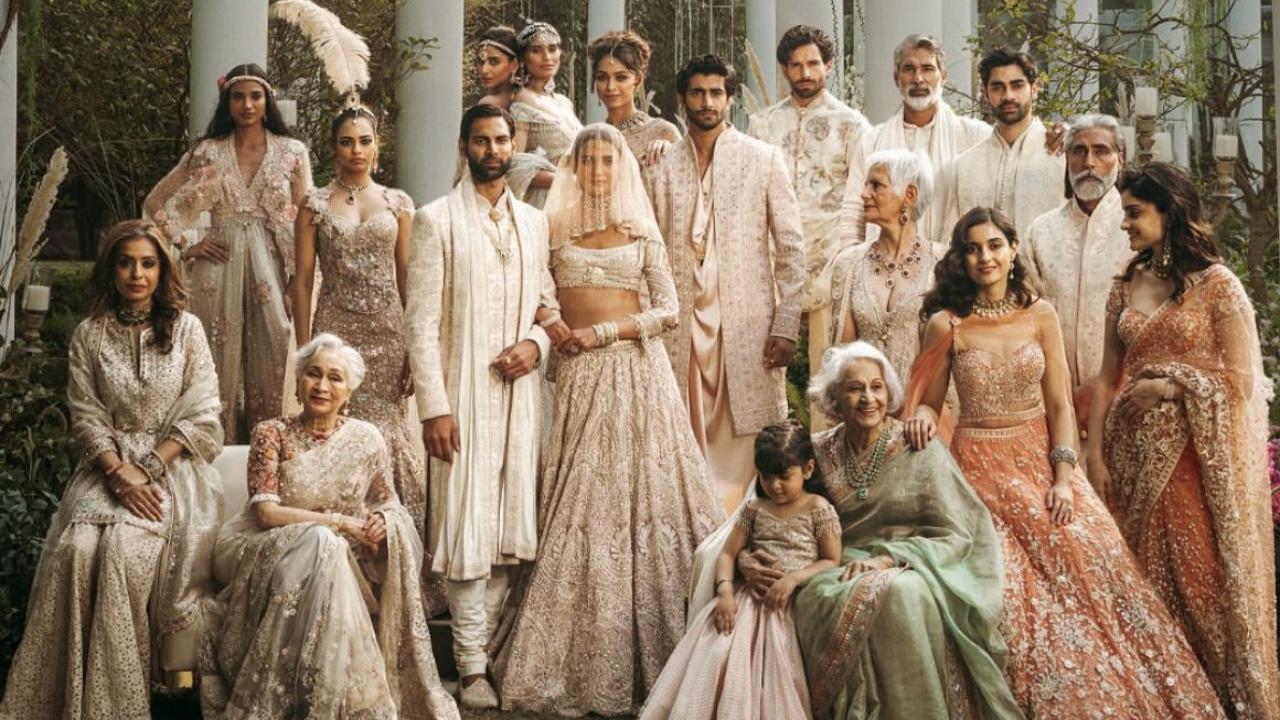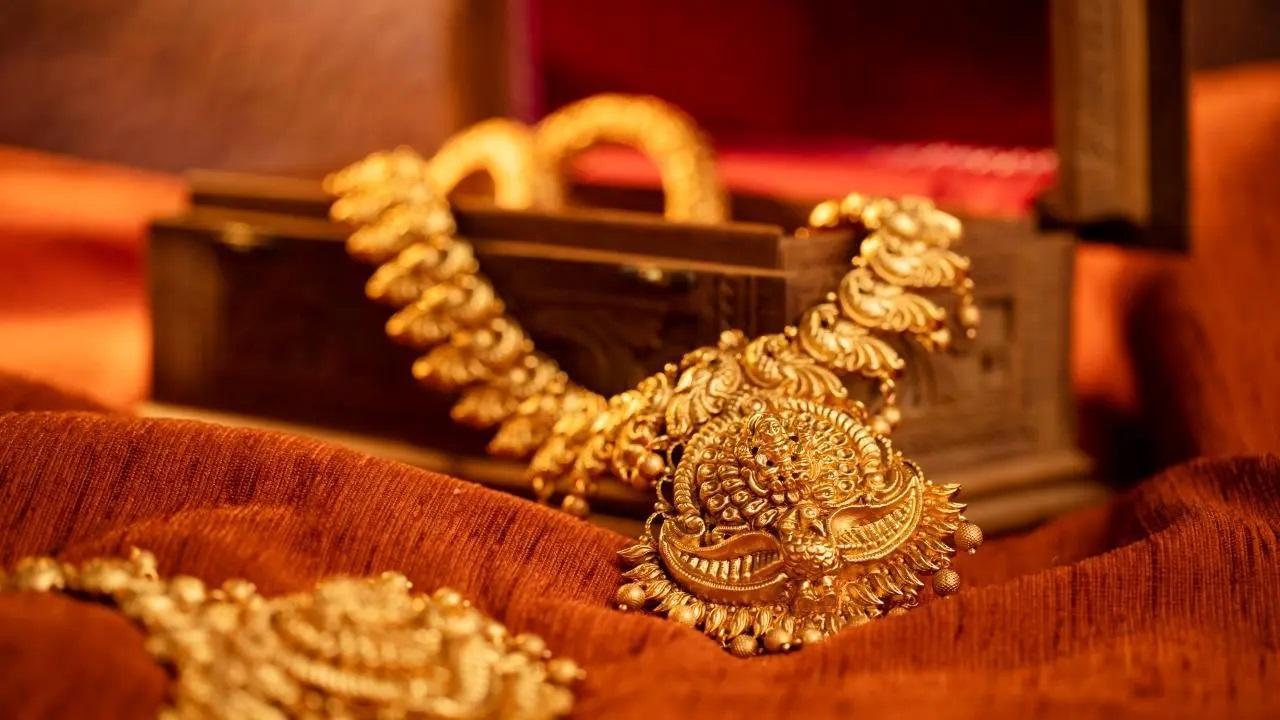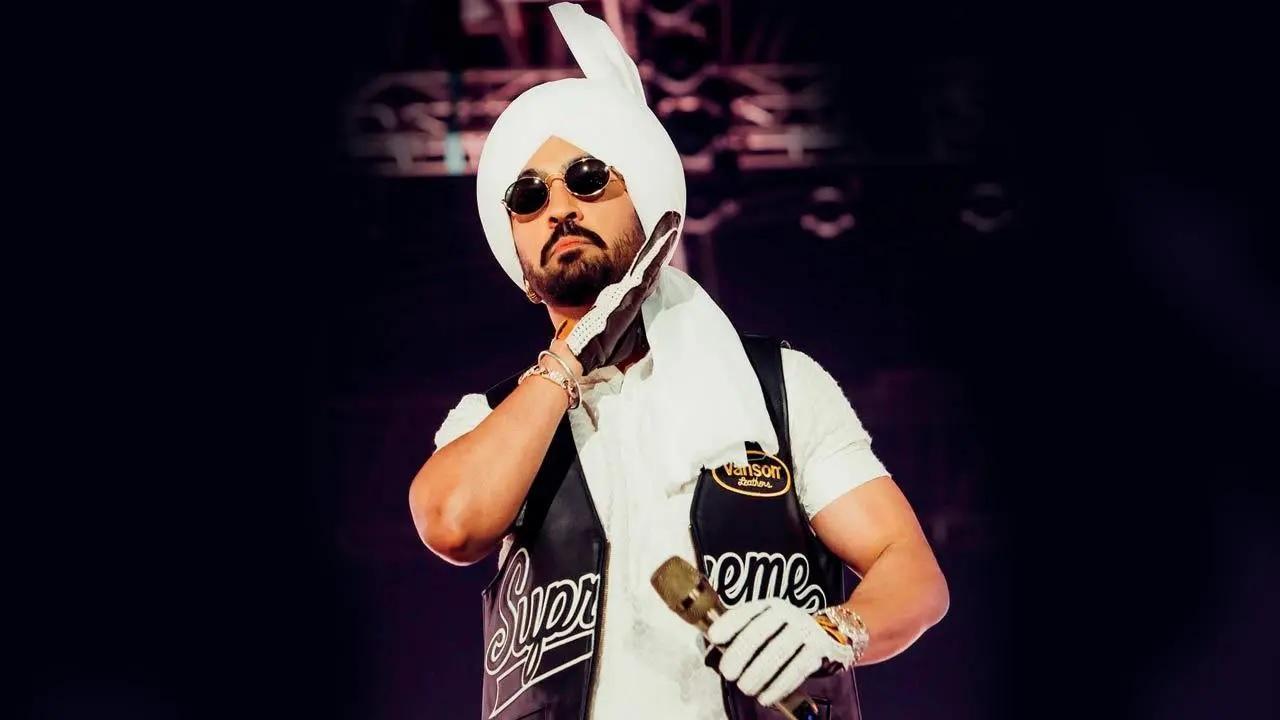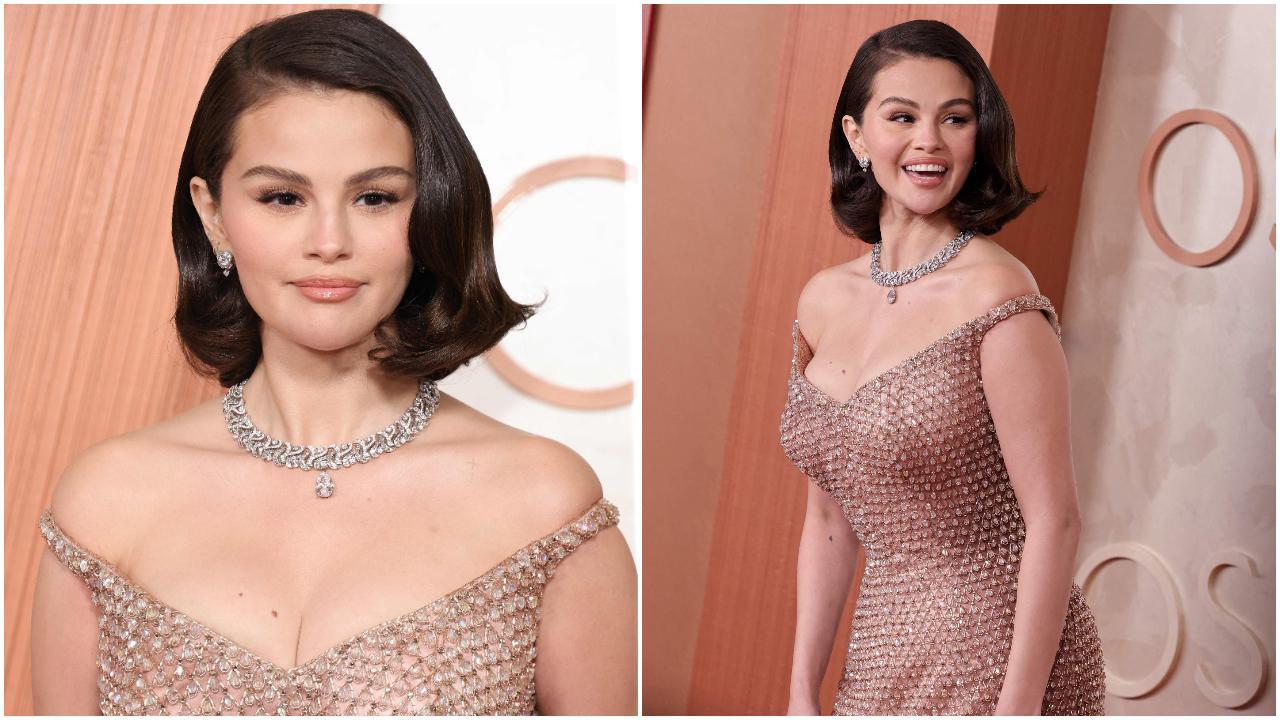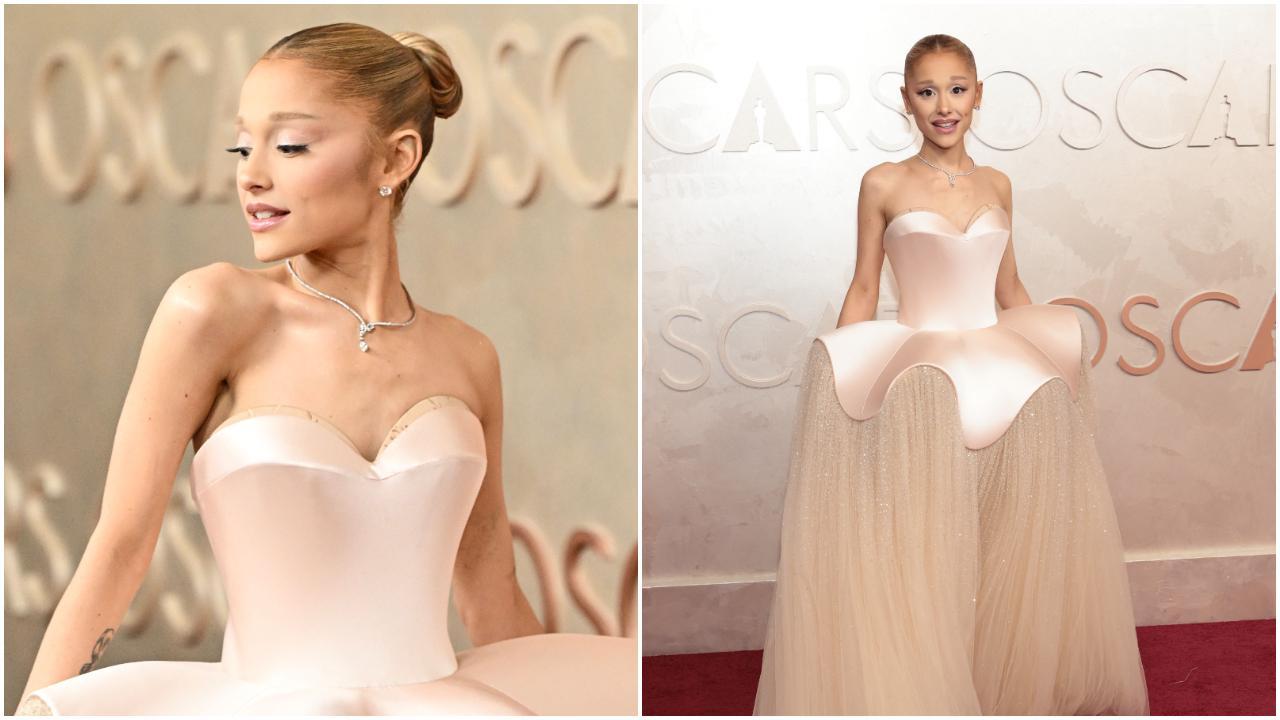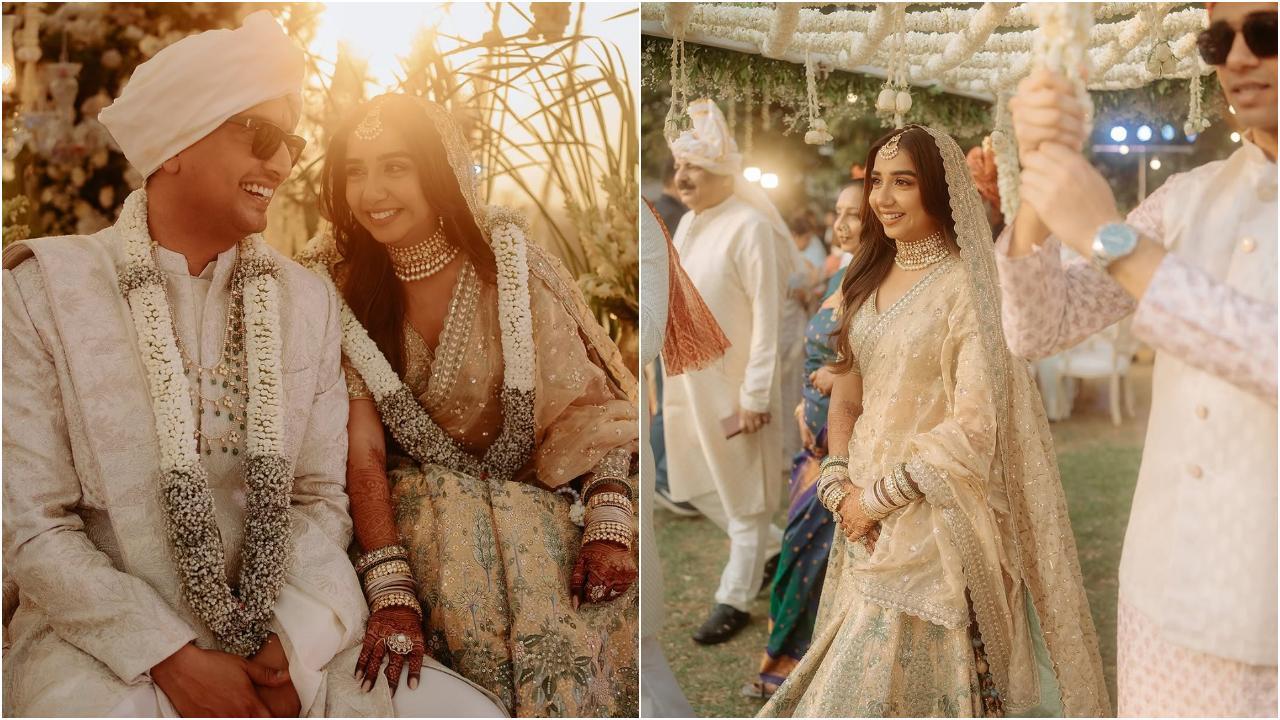Read Fashion News
Lakmé Fashion Week 2025: Anamika Khanna’s collection redefines power dressing
Ace designer Anamika Khanna opened Lakmé Fashion Week 2025, in partnership with FDCI, with a collection from her signature label AK|OK at Jio World Convention Centre in Mumbai on Wednesday. The collection, titled ‘Silver Collar’ stayed true to its name as it presented a unique take on workwear, that was neither conventional nor drab. Adorned with silver chains, embellishments and ornaments, the outfits redefined power dressing. The ‘silver’ stood out against the backdrop of black, white and other silhouettes, with ornate jewellery like silver bracelets, armlets and statement neckpieces elevating the elegance of the outfits. Ananya Panday turns showstopper Ananya Panday turned showstopper for the opening show. Ananya Panday turned showstopper for Anamika Khanna's signature label AK|OK at Lakmé Fashion Week X FDCI 2025 (Photo Courtesy: Satej Shinde) The actor donned a dazzling blue and silver outfit. The palazzo pants featured silver embellishments and round cuts on the side, while the blouse was covered with several silver chains. The ensemble also included a chained pallu. Silver bangles and blue anke-length heel boots completed the look. Panday’s hair were styled in a neat bun. Speaking to ANI about her look, she said, "I'm wearing this silver metallic outfit. It has electric blue. I feel like I'm wearing armor, and I feel very strong in it." In the last edition of the fashion week, the actor had closed the grand finale show, turning showstopper for late designer Rohit Bal. Anamika Khanna at Lakmé Fashion Week This year’s opening show by Anamika Khanna set a radiant tone for the fashion spectacle that is to follow. The designer herself wore an all-black ensemble with a subtle yet striking touch of silver. View this post on Instagram A post shared by Lakmē Fashion Week (@Lakméfashionwk) Khanna is a veteran at this runway, having previously captured the attention of fashion lovers at other editions of Lakmé Fashion Week. Last year, she had brought alive colours and motifs inspired by Orissa’s Bonda tribe through her collection, with Shanaya Kapoor turning the showstopper. Lakmé Fashion Week X FDCI 2025: What to know This fashion extravaganza will continue in Mumbai till Sunday, with a star-studded line-up of designers including Amit Aggarwal, Falguni Shane Peacock, Tarun Tahiliani, Shivan and Narresh, Shantnu Nikhil, Rahul Mishra and Manish Malhotra. The event will also spotlight emerging talent and homegrown brands. Also Read: Lakmé Fashion Week 2025: Dates, designers and everything you need to know
27 March,2025 10:04 AM IST | Mumbai | mid-day online correspondentLakmé Fashion Week 2025: Dates to designers list, here's all you need to know
Lakmé Fashion Week 2025, in collaboration with the Fashion Design Council of India (FDCI), is set to take place from March 26 to March 30 at the Jio World Convention Centre in Mumbai. The fashion extravaganza will mark its 25th anniversary this week. From designers to event schedule, here’s all you need to know about this edition. Lakmé Fashion Week 2025 X FDCI: What to expect Continuing its legacy, this edition of Lakmé Fashion Week X FDCI will showcase collections from renowned designers, as well as provide a platform for emerging talent to shine. One can expect to witness trend-setting designs that are a blend of luxury and sustainability. Apart from spotlighting veterans of the fashion world, the event also includes initiatives like GenNext for encouraging emerging talent, and the Circular Design Challenge to promote sustainability. Lakmé Fashion Week 2025 X FDCI designers This edition presents an exciting line-up of designers and homegrown brands. Anamika Khanna will open the fashion week with her signature label AK|OK on Wednesday. Over a course of five days, the event will feature a star-studded line-up of fashion designers including Amit Aggarwal, Falguni Shane Peacock, Tarun Tahiliani, Shivan and Narresh, Shantnu Nikhil, Rahul Mishra and Manish Malhotra. Check the full schedule here: View this post on Instagram A post shared by Lakmē Fashion Week (@lakmefashionwk) The last edition of Lakmé Fashion Week X FDCI was held in October 2024 in New Delhi, and presented several fashion highlights ranging from exquisite traditional collections to experimental style statements. Rohit Bal presented the grand finale collection, which was also the ace designer’s last show before his unfortunate passing in November 2024. Also Read: Lakmé Fashion Week 2024: Of familiar stomping grounds and then some
26 March,2025 11:31 AM IST | Mumbai | mid-day online correspondentTarun Tahiliani unveils his fashion film 'Timeless' directed by Reema Kagti
Indian fashion designer Tarun Tahiliani has unveiled his first-ever fashion film, 'Timeless', a breathtaking ode to love, family, and the deep bonds that make weddings so magical. Directed by the acclaimed Reema Kagti, the film captures the essence of homecoming, joy, and celebration, all wrapped in the signature elegance of Tarun Tahiliani’s Summer Wedding Edit 2025. 'Timeless' beautifully weaves together a visual narrative that transcends fleeting trends, embracing the eternal charm of the Indian designer's couture. Through Kagti’s lens, each frame exudes the poetry of affection and heartfelt connections, where traditions meet modernity in a seamless blend. The film unfolds in an intimate setting, where shared laughter, whispered promises, and cherished moments are brought to life with an ethereal touch. “Fashion, to me, has always been about storytelling, about capturing moments that last forever. With Timeless, we celebrate the beauty of love and the craftsmanship that defines our designs,” shares Tahiliani. Director Reema Kagti adds, “This is my first fashion film, and I’m thrilled to collaborate with my dear friend Tarun Tahiliani. It was a joy to bring his vision to life and express his world of fashion through my lens. This film is a tribute to design that is truly timeless.”
20 March,2025 12:32 PM IST | Mumbai | mid-day online correspondentTanishq expands US presence with new stores in Seattle and Atlanta
Indian jewelry brand from the TATA Group, Tanishq, is expanding its presence in the US market, opening new stores in the states of Washington and Georgia. Tanishq opened its fifth and sixth US stores in Redmond, Washington and Cumming, Georgia, respectively, marking a significant milestone in its North American expansion, a press release said. The brand continues to make waves in the US market, offering a sophisticated collection of fine gold and diamond jewelry tailored for both South Asian traditions and contemporary American tastes, it said. The 3,640 sq. ft showroom in Redmond near Seattle also has over 5,000 pieces on display and caters to a growing community that values quality craftsmanship, transparency and ethical sourcing. The opening was attended by Consul General of India in Seattle, Prakash Gupta, and Mayor of Redmond Angela Birney, Tanishq USA said. With Seattle emerging as a thriving hub for professionals and families who cherish both tradition and modernity ¿ Tanishq's arrival brings a trusted fine jewelry destination to a community that deeply values Indian craftsmanship, heritage and innovation,¿ the press release added. The 3,270 sq. ft store in Georgia features over 5,000 designs, including bridal collections and daily essentials. The company said Atlanta, Georgia, one of the fastest-growing cities in the US and a dynamic retail landscape, was a ¿natural choice for Tanishq's latest expansion, ensuring accessibility to a diverse and discerning clientele seeking fine jewelry for weddings, festivals, and everyday elegance¿. The opening was attended by Consul General of India in Atlanta, Ramesh Babu Lakshmanan, along with prominent guests and customers. Titan Company Limited Business Head - North America Amrit Pal Singh said ¿our journey in the U.S. is just beginning and Atlanta and Seattle are key markets for us. We are proud to bring Tanishq's exceptional craftsmanship and trust to additional vibrant and diverse communities, providing a destination for fine jewelry that seamlessly blends heritage and innovation¿. Tanishq also has stores in New Jersey, Houston, Dallas and Chicago in the US. This story has been sourced from a third party syndicated feed, agencies. Mid-day accepts no responsibility or liability for its dependability, trustworthiness, reliability and data of the text. Mid-day management/mid-day.com reserves the sole right to alter, delete or remove (without notice) the content in its absolute discretion for any reason whatsoever.
12 March,2025 03:29 PM IST | New York | PTILevi's appoints Diljit Dosanjh as global brand ambassador; becomes first Punjabi
Levi's(r) has appointed global icon Diljit Dosanjh as its newest ambassador. Known for rewriting the rules of music, cinema, and style, Diljit joins the Levi's(r) family as the first Punjabi artist as part of the brand's ever-growing community of creative talent. Hot on the heels of his record-breaking Dil-Luminati Tour and history-making Coachella debut, this partnership blends the timeless appeal of Levi's(r) with Diljit's trailblazing journey. From G.O.A.T. to Lover, and now an Icon set to #LiveInLevis, it's a celebration of two icons redefining culture--together. Drawing inspiration from Diljit's unique ability to connect across borders and genres, this collaboration highlights the Levi's(r) brand's role as a canvas for self-expression. From his early hits in Punjabi cinema to charting on the Billboard Social 50, Diljit's story is all about bold choices, just like the blue jeans that have stood the test of time for over 170 years. "I've always admired Levi's(r) for the way it blends heritage with modern style," says Diljit Dosanjh. "Denim is more than just clothing to me--it's a statement. Partnering with Levi's(r) feels like the perfect fit." Amisha Jain, managing director and SVP, South Asia, Middle East, Africa, and Non-EU at Levi Strauss & Co., adds, "Diljit Dosanjh perfectly embodies the progressive spirit of Levi's(r). His phenomenal journey perfectly aligns with our brand's spirit of empowering self-expression through music, fashion, and culture. Together, we're set to create something truly iconic." This partnership showcases Levi's(r) expanding menswear range, including on-trend New Loose and Relaxed fits, while reflecting Diljit Dosanjh's innate sense of style. Building on the success of the Dil-Luminati Tour merchandise, it seamlessly blends music and fashion.
05 March,2025 12:01 PM IST | Mumbai | mid-day online correspondentOscars 2025: Guneet Monga shines in contemporary saree by Manish Malhotra
Producer Guneet Monga aced her look for Oscars 2025 as she celebrated India in a contemporary saree by Manish Malhotra, blending traditional and modern styles. The hand-woven tissue outfit featured a constructed corset paired with a saree, complemented by a unique drape and trench coat. She styled the mocha mousse outfit with a clutch and stud earrings from Malhotra’s fine jewellery label. Apart from a unique blend of styles, this outfit is an interesting choice for another reason – its colour. Mocha mousse was named ‘Pantone Colour of the Year’ for 2025, and has been in the spotlight since then. Malhotra took to his Instagram handle to commend Monga’s bold and elegant representation of Indian heritage on the global stage. Sharing her photos, he wrote, “The fabulous @guneetmonga looking elegant and regal, making a strong style statement in Indian contemporary fashion, celebrating the saree with a constructed corset and trench in the special color of the year, Mocha Mousse. An ensemble in handwoven handloom tissue- an Indian-rooted fabric- and the Indian contemporary saree, worn with our jewellery: imperial heirlooms, uncut diamonds, and 18K gold… on the global stage @theoscarsworld .... #mymmsaree #guneetmonga styling @manishamelwani @manishmalhotrajewellery @manishmalhotraworld.” View this post on Instagram A post shared by Manish Malhotra (@manishmalhotra05) At the Oscars, short film “Anuja”, produced by Guneet Monga and others, was nominated for Best Short Film (Live Action), but lost to the Dutch film “I'm Not a Robot”. At the 2023 Academy Awards, where the documentary “The Elephant Whisperers” won an award, Monga had made a statement by wearing a traditional pink Benarasi saree adorned with elephant motifs. This year, she embraced a modern twist on the saree, bringing contemporary flair to the global stage. (With inputs from IANS)
03 March,2025 01:44 PM IST | Los Angeles | mid-day online correspondentOscars 2025: Demi Moore stuns on red carpet in a plunging neckline gown
The 97th annual Academy Awards have officially kicked off, and the stars are shining bright on the red carpet. Among the A-listers making a fashion statement is actress Demi Moore, who looked absolutely radiant in a custom Giorgio Armani Prive crystal-embroidered gown. Moore, who is nominated for Best Actress for her role in 'The Substance,' stunned in the plunging neckline gown, which featured pleated hip detailing and a dramatic train. The 62-year-old actress added some extra sparkle with matching earrings and a bracelet, and her long, dark hair cascaded into soft curls. Ahead of the ceremony, Moore's daughter, Scout Willis, teased that her mom's Oscars look would be "iconic, no matter what," as per People magazine. And going by the photos, it's clear that Moore delivered! This is Moore's first-ever Oscar nomination, and she's already having a winning streak this awards season. She has taken home prizes at the Golden Globe Awards, Critics Choice Awards, and Screen Actors Guild Awards for her role in 'The Substance.' The film, which also stars Margaret Qualley and Dennis Quaid, is up for several awards, including Best Picture, Best Original Screenplay, and Best Makeup and Hairstyling. Moore's director, Coralie Fargeat, is also nominated for Best Director, making her the only woman in the category. The 2025 Oscars are being hosted by Conan O'Brien and will air live at 7 pm ET on ABC and Hulu. In India, the Academy Awards will stream live on JioHotstar.
03 March,2025 09:43 AM IST | Los Angeles | ANIOscars 2025: Selena Gomez sparkles in rose gold gown
Selena Gomez knows best how to catch attention with her fashion statement. A while ago, she arrived at the Academy Awards and looked gorgeous as ever. Donning an off-shoulder rose gold Ralph Lauren gown dripping in crystals, Selena happily posed for shutterbugs on the red carpet. Styled by Molly Dickinson, Gomez's look was inspired by Sophia Loren -- and she even worked with the iconic superstar's tailor to customise her look, according to E! News correspondent Zanna Roberts Rassi, Page Six reported. The dazzling design's embellished with over 16,000 glass droplets and Rosemont crystals, all sewn on by hand by a team of 12 artisans. The "Emilia Perez" star accessorised the spectacular piece with even more sparkle courtesy of Bulgari jewellery, including a stunning diamond choker necklace, matching earrings and two diamond rings (in addition to her sparkler from fiance Benny Blanco). Though Gomez didn't receive an individual nomination for her role as Jessi Del Monte in "Emilia Perez," the musical-crime film scored 13 nods this evening, more than any other movie. This story has been sourced from a third party syndicated feed, agencies. Mid-day accepts no responsibility or liability for its dependability, trustworthiness, reliability and data of the text. Mid-day management/mid-day.com reserves the sole right to alter, delete or remove (without notice) the content in its absolute discretion for any reason whatsoever.
03 March,2025 09:24 AM IST | Los Angeles | ANIOscars '25: Ariana Grande stuns in pink gown covered in thousands of crystals
Singer-actor Ariana Grande left everyone in awe with her stunning red carpet look for Oscars 2025. She arrived at the Dolby Theatre wearing a flared-out nude corset with pale tulle netting attached. The superstar singer and her stylist Mimi Cuttrell selected a blush pink Schiaparelli Spring/Summer 2025 Haute Couture strapless bustier gown with a bodice that extended into a sculptural peplum waist. The design also featured a voluminous nude-coloured skirt covered in more than 190,000 sequins and rhinestones that complemented the sparkle of her blingy necklace, as per People. https://www.instagram.com/p/DGtvMW6s5HX/?hl=en&img_index=1 According to the brand, the gown is enhanced with a clam basque inspired by an Alberto Giacometti lamp from the Maison archive. This year's edition of The Academy Awards is extremely special for Ariana as she is up for best supporting actress for her performance as Glinda in "Wicked," which heads into the Oscars with 10 nominations, including best picture, as per Variety. "I am so excited to be here," Grande said, "It's not something I ever dreamed of in my wildest dreams. The gift of my life was playing Glinda. So this part. I didn't let my mind go this far. You don't expect this thing. Doing the work is the gift. This is just such a surreal acknowledgement and cherry on top. To be included with so many actors and actresses I love so much. This whole circuit has been an amazing dream." This story has been sourced from a third party syndicated feed, agencies. Mid-day accepts no responsibility or liability for its dependability, trustworthiness, reliability and data of the text. Mid-day management/mid-day.com reserves the sole right to alter, delete or remove (without notice) the content in its absolute discretion for any reason whatsoever.
03 March,2025 09:13 AM IST | Los Angeles | ANIPrajakta Koli’s wedding lehenga has a connection to her name; check details here
Actor and content creator Prajakta Koli, aka MostlySane, tied the knot with long-time partner Vrishank Khanal in an intimate wedding ceremony in Karjat on Tuesday. The bride and groom stunned in custom ensembles by fashion designer Anita Dongre on the special day. While Prajakta opted for a cream-coloured lehenga, Vrishank complemented her with an ivory sherwani. The outfits were nature-inspired and featured intricate detailing. About Prajakta Koli’s outfit Prajakta donned a hand-painted Pichhwai lehenga with motifs of palm trees and Parijaat flowers. Anita Dongre took to Instagram to reveal that the lehenga held special meaning as it was an ode to Prajakta, which is another name for the flowers depicted in the outfit. The voluminous lehenga skirt also featured delicate sequins, elevating the radiance of the outfit. View this post on Instagram A post shared by Prajakta Koli (@mostlysane) An embellished blouse, matching dupatta and a beautiful veil completed the ensemble. The jewellery, also by Anita Dongre, included a mang tika, choker necklace, statement earrings, rings, kadhas and bangles. The bride opted for minimal make-up, and open hair styled into soft waves. About Vrishank Khanal’s outfit The groom wore a hand-embroidered silk sherwani, featuring nature-inspired motifs like trees. He paired it with matching pants, shoes and safa. About Pichhwai art Pichhwai is a traditional form of painting from Rajasthan, which explores themes related to the life of Lord Krishna, also celebrating the co-existence of different inhabitants of nature. Floral motifs are a common occurrence in Pichhwai paintings. This art form is characterised by vibrant colours and intricate detailing. Also Read: Prajakta Koli-Vrishank Khanal mehendi ceremony: Anita Dongre creates custom looks that will give you fashion inspiration
26 February,2025 02:50 PM IST | Mumbai | mid-day online correspondentPrajakta Koli-Vrishank Khanal mehendi ceremony: Anita Dongre creates custom look
Bringing together craftsmanship and conscious design, Anita Dongre created custom mehendi ensembles for both Prajakta Koli and her fiancé, Vrishank Khanal, intricately handcrafted by the artisans of SEWA (Self-Employed Women’s Association)— a women-led cooperative founded in 1972, that empowers artisans through sustainable livelihoods while preserving India’s rich textile and embroidery traditions. For the celebration, Prajakta wore the Flora Forest Skirt Set, a silk creation adorned with exquisite hand embroidery inspired by the flora and fauna of the forest. Each motif was meticulously crafted over months by SEWA artisans, blending tradition with timeless artistry. She paired her look with Anita Dongre’s signature jewellery—modern heirlooms designed for the woman who embraces her roots with a contemporary aesthetic. Handcrafted by master artisans in Rajasthan, the pieces are made in 92.5 sterling silver, ensconced in zircon crystals, and feature architectural details and nature-inspired motifs that reflect elegance and heritage. Vrishank complemented her in a Tree Greens Embroidered Silk Nehru Jacket Set by Anita Dongre, featuring intricate zardozi and threadwork embroidery on silk, echoing nature’s effortless beauty through impeccable craftsmanship.
25 February,2025 02:06 PM IST | Mumbai | mid-day online correspondent





